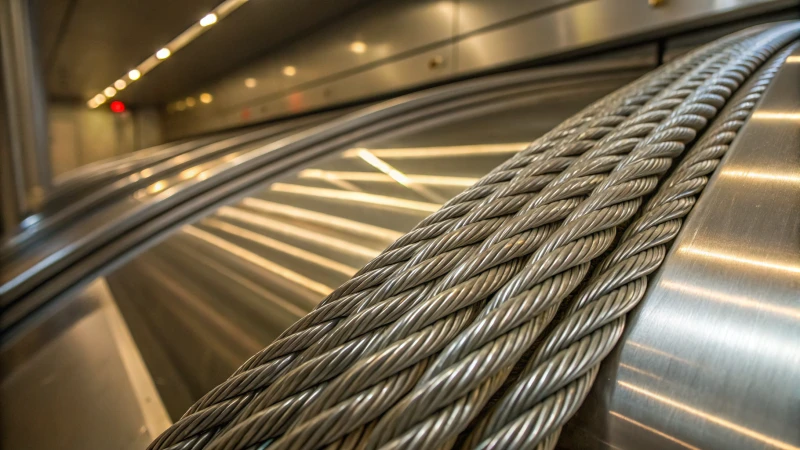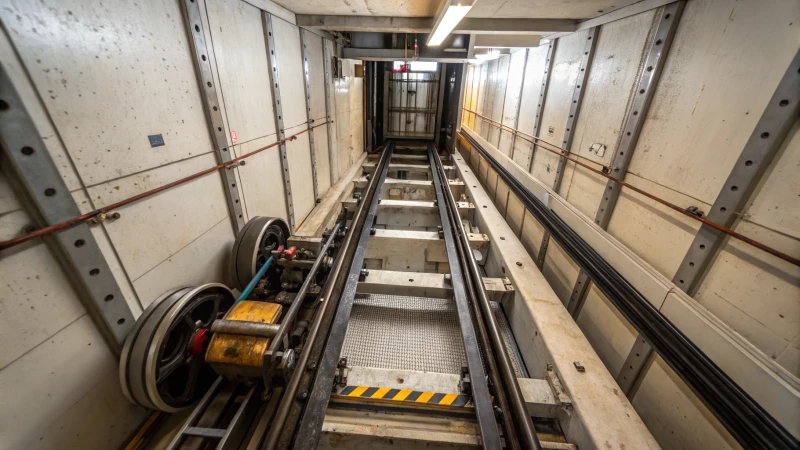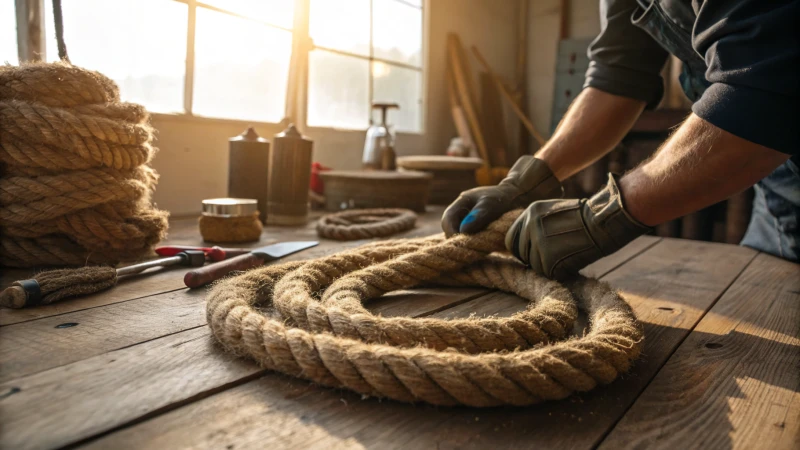
Let me share with you how something as simple as vibration can affect the steel wire ropes in elevators, and why it matters more than you might think.
Vibration impacts elevator steel wire ropes by increasing internal friction and abrasion, which leads to fatigue and reduces their lifespan. By selecting optimized rope constructions and protective coatings, these effects can be minimized, ensuring longer-lasting durability and reliability in elevator systems.
I remember the first time I learned about this—standing in an elevator, listening to the quiet hum of the cables. It struck me how these unseen ropes were crucial to our safety and daily convenience. Understanding the underlying mechanics is vital; not just to fix problems, but to prevent them. Once you dive into the specifics, like opting for specialized constructions such as 6×36 or 8×19, or using polymer coatings, the benefits are clear. These measures can effectively extend the rope's life, making each ride smoother and safer. It's fascinating how much thought goes into something we often overlook.
Vibration causes internal friction in elevator ropes.True
Vibration induces internal friction, leading to wear and tear.
Protective coatings increase rope lifespan against vibration.True
Coatings reduce abrasion from vibration, extending rope life.
Why Does My Elevator Feel Like It's Vibrating?
Ever found yourself in an elevator that felt like it was dancing a little too much? It’s not just unsettling—it might be signaling a deeper issue.
Elevator vibrations often arise from mechanical imbalances, misalignment of parts, or wear and tear on guide rails and rollers. Regular maintenance and accurate installations are key to reducing these vibrations effectively.

I've been there—standing in an elevator, clutching my coffee, when suddenly, the floor beneath me starts to shiver like it's got a secret. If you've experienced this, you know it’s not exactly a confidence booster. And while I'm no elevator whisperer, I've dug into why these metal boxes sometimes get the shakes.
Mechanical Imbalances
Mechanical imbalances are a common cause of elevator vibrations. Picture this: you're at a party, and someone decides to carry an unbalanced tray of drinks. Every step sends a ripple through the glasses. Similarly, elevators can experience mechanical imbalances when the weight isn't distributed evenly or when counterweights and pulleys are off-kilter.
I once spoke with an elevator technician who likened it to walking with one shoe thicker than the other—it throws everything off balance. Regular check-ups can catch these issues early before they lead to bigger, more costly problems.
Guide Rails and Roller Issues
Guide rails and rollers play a critical role in stabilizing elevator movement. Over time, wear and tear on these components can lead to increased vibrations. Imagine trying to skate on a road full of potholes—it's not going to be smooth sailing. Similarly, if guide rails aren’t aligned properly or if rollers become worn out, you might feel your ride shake more than usual.
Implementing a schedule for regular inspection and lubrication of these parts can significantly reduce wear and improve ride quality.
Electrical Components and Controls
Sometimes the culprit isn’t mechanical but electrical. Faulty control systems or issues with the motor drive can lead to erratic movements. It's like trying to drive a car with a malfunctioning GPS—you might end up taking some unexpected turns.
Ensuring that all electrical systems are up to par and regularly checked can save you from those awkward elevator dances.
Installation and Calibration Errors
Improper installation or calibration can set the stage for ongoing vibration problems. Think back to any DIY project where "close enough" turned out to be not quite right. The same goes for elevators; if they’re not installed by pros or calibrated correctly, they might have ongoing vibration issues.
Professional installation ensures every component is just right so you don't end up with an elevator that's more funhouse ride than transport vehicle.
External Influences
Finally, external factors such as building sway or environmental conditions can also contribute to elevator vibrations. In tall buildings, wind-induced sway may impact elevator stability—kind of like trying to walk straight in a gusty breeze.
Engineers need to account for these variables during design and installation phases.
Using dampening systems within the shaft can help combat these external forces, ensuring your elevator rides are as smooth as possible.
| Cause | Description | Solution |
|---|---|---|
| Mechanical Imbalance | Uneven weight or pulley issues | Regular maintenance |
| Guide Rail Wear | Misalignment or worn rollers | Inspections & lubrication |
| Electrical Faults | Malfunctioning controls | Proper calibration |
| Installation Errors | Misalignment of parts | Professional installation |
| External Factors | Building sway | Use of dampeners |
Understanding these causes helps us take proactive measures. Ensuring that elevators operate smoothly and safely isn't just about comfort—it's about trust and peace of mind. Exploring innovative solutions1 is crucial for maintaining modern elevator systems efficiently.
Mechanical imbalances cause elevator vibrations.True
Uneven weight distribution or unbalanced components lead to oscillations.
Guide rails never affect elevator stability.False
Worn or misaligned guide rails can increase elevator vibrations.
How Can Rope Construction Mitigate Vibration Effects?
Ever wonder how something as simple as rope can play a role in taming the wild vibrations that wreak havoc on machinery?
Rope construction can significantly reduce vibration effects by increasing both flexibility and durability. Configurations like 6×36 and 8×19 are particularly effective, while polymer coatings further enhance vibration resistance, minimizing wear and extending rope lifespan.

Understanding Rope Construction
I've spent countless hours pondering the intricate designs of steel wire ropes, especially those used in heavy machinery2. You see, these ropes aren't just strands twisted together; they're a lifeline for the equipment we rely on every day. Imagine ropes that can flex and bend, reducing the friction that causes wear and tear—it's all about selecting the right construction type. The 6×36 and 8×19 configurations are like the unsung heroes here, offering that much-needed flexibility.
Material Enhancements
Think back to when you wrapped a favorite book in a protective cover to keep it safe from the elements. That's what adding a layer of PVC or polyurethane3 does for these ropes. These coatings are like shock absorbers, standing between the metal strands and the harsh external forces that try to wear them down. It's akin to giving your rope a superhero cape that shields it from the worst vibrations.
Shock-Absorbing Core Design
When I first heard about ropes with shock-absorbing cores, it was like discovering a hidden secret. These specialized elastomers nestled within the rope work wonders in soaking up those relentless vibrations. Following the ISO 18151 standard4, these designs can extend a rope's life by up to 30%—that's like giving your rope a new lease on life.
Comparative Analysis of Rope Configurations
| Configuration | Flexibility | Vibration Resistance | Application |
|---|---|---|---|
| 6×36 | High | Moderate | General industrial use |
| 8×19 | Moderate | High | Specialized machinery |
| Polymer-Coated | High | Very High | Corrosive environments |
Real-World Applications
In my line of work, I often see these advanced rope constructions making waves in industries like construction and mining. Picture elevator systems5 humming smoothly thanks to vibration-resistant ropes or mining operations running safely with durable ropes that hold up under immense pressure.
Technical Support and Innovations
It's no secret that finding the right supplier can be a game-changer. Companies like WonBon aren't just about selling ropes; they're about creating partnerships. When you get expert consultation6 tailored to your specific needs, it's like having a personal guide through the labyrinth of safety standards and product innovations.
6×36 rope configuration offers high flexibility.True
The 6×36 configuration is known for its high flexibility, ideal for industrial use.
Polymer-coated ropes have low vibration resistance.False
Polymer coatings provide very high vibration resistance, protecting the rope from wear.
How Do Coatings Protect Wire Ropes?
Ever wonder how wire ropes withstand the harshest conditions? It’s not magic, it’s all about the coatings!
Coatings on wire ropes serve as a vital protective shield, enhancing their resistance to corrosion and wear. This protection significantly extends the ropes’ lifespan by minimizing damage from friction and environmental elements.

Enhancing Durability with Coatings
I remember the first time I saw a wire rope being used in a massive construction project; it was like watching a giant, metallic snake weaving through the air. I couldn’t help but wonder how these ropes stayed strong amidst all the dust, moisture, and friction. The secret? Coatings. These coatings act like armor for the ropes, with materials like PVC or polyurethane providing flexibility and strength, ensuring that even under bending stresses, the ropes don't let moisture seep in.
Types of Coatings and Their Benefits
| Coating Material | Benefits |
|---|---|
| PVC | Cost-effective, good corrosion resistance |
| Polyurethane | Excellent abrasion resistance |
| Nylon | High tensile strength, good impact resistance |
The choice of coating material is crucial, depending on the application and budget. Each type offers unique advantages that can greatly enhance the mechanical properties7 of the wire ropes.
Reducing Vibration-Induced Wear
I’ve seen wire ropes in action in elevators and let me tell you, the constant vibration is no joke. It’s like a never-ending marathon for these ropes, and without the right protection, they’d wear out quickly. Advanced polymer coatings help by absorbing vibrations, allowing the ropes to last up to 30% longer. Imagine running that marathon in cushioned shoes versus barefoot – that’s the difference these coatings make.
An advanced polymer coating can increase resistance by distributing stress across the rope's surface more evenly. Studies have shown that coated ropes can last up to 30% longer in high-vibration environments compared to their uncoated counterparts.
Improving Safety and Performance
Safety is something I never compromise on, especially when it comes to lifting heavy loads. By reducing wear and corrosion, coatings not only extend the lifespan of wire ropes but also enhance safety. This reliability cuts down on maintenance and operational risks – a huge relief for anyone responsible for heavy lifting operations.
The coatings also play a critical role in maintaining the integrity of the rope's core8, which is essential for its load-bearing capacity. A solid core means no unexpected failures, which is exactly what procurement managers like John or Emma need to ensure their projects run smoothly while optimizing costs with less maintenance.
Coatings prevent wire rope corrosion.True
Coatings act as a shield, protecting wire ropes from corrosive elements.
Nylon coatings are cost-effective.False
Nylon offers high tensile strength but is not the most cost-effective option.
How can regular maintenance enhance rope longevity?
Ever wondered how keeping your ropes in top shape could save you time, money, and stress?
Regular rope maintenance, including cleaning, inspecting, and proper storage, is crucial for longevity. By preventing damage and ensuring safety, these practices reduce environmental wear and tear, extending the usable life of your ropes.

I remember the time when I first started using ropes for outdoor adventures. Back then, I didn’t really think much about their upkeep. But after a close call with a frayed rope during a climbing trip, I quickly learned the value of regular maintenance.
Importance of Cleaning
Cleaning isn’t just about appearances; it’s about keeping those fibers strong and ready for action. Regular cleaning removes dirt and debris that can cause abrasion9 and weaken rope fibers. Use mild soap and water for synthetic ropes, avoiding harsh chemicals that could weaken them over time. For natural ropes, a good dry brushing works wonders.
| Rope Type | Cleaning Method |
|---|---|
| Synthetic | Mild soap and water |
| Natural | Dry brushing or air blowing |
Inspection Techniques
When you’re inspecting ropes, think of it like checking in with an old friend. Inspect ropes frequently for signs of wear, such as fraying or discoloration. Pay attention to areas near terminations or connections, as these are prone to stress. Spotting damage early can prevent accidents.
- Check for Fraying: This indicates potential failure points.
- Look for Discoloration: UV exposure may weaken the rope.
Proper Storage Practices
Storing ropes correctly is another essential habit. Store ropes in a cool, dry place away from direct sunlight to prevent UV damage. Coiling them neatly avoids kinks that could compromise their strength.
- Avoid Direct Sunlight: UV rays break down rope materials.
- Keep Dry: Moisture can lead to mildew in natural ropes.
Role of Coatings
I’ve also experimented with coatings like PVC or polyurethane, which act as shields against wear from environmental elements. Applying protective coatings can enhance a rope's resistance to wear by acting as a barrier against moisture and UV light.
Vibration Resistance in Ropes
In high-vibration settings, flexible cores and shock-absorbing features are game-changers. In environments with constant vibration, choosing ropes with these features is crucial as they can extend rope life by up to 30%—a real boon for anyone using ropes in dynamic environments.
- Flexible Cores: Reduce internal friction.
- Shock Absorption: Minimizes wear from movement.
Discover Vibration Resistant Ropes12
Maintaining your ropes isn't just about keeping them clean and tidy—it's about ensuring they’re ready to perform when you need them most. Understanding the factors that affect wear and employing these best practices can significantly prolong their effective use.
Regular cleaning prevents rope abrasion.True
Cleaning removes dirt and debris that cause abrasion, weakening fibers.
UV exposure strengthens rope materials.False
UV exposure actually weakens rope materials, causing degradation.
Conclusion
Vibration significantly impacts elevator steel wire ropes by increasing wear and reducing lifespan. Optimized constructions and protective coatings can mitigate these effects, enhancing durability and safety.
-
Learn about innovative solutions that help address elevator vibration issues, enhancing performance and safety in modern systems. ↩
-
Explore how heavy machinery industries implement steel wire ropes for enhanced durability under stress. ↩
-
Learn about how polymer coatings protect steel wire ropes from wear and vibration. ↩
-
Understand ISO 18151 standards for designing vibration-resistant steel wire ropes. ↩
-
Discover how steel wire ropes are used to minimize vibrations in elevators. ↩
-
Find out how technical support enhances steel wire rope procurement processes. ↩
-
This link provides insights into how coatings enhance the mechanical properties of wire ropes, crucial for procurement decisions. ↩
-
Understand why maintaining the integrity of a wire rope's core is critical for safety and performance by exploring this resource. ↩
-
Explore how dirt increases abrasion, weakening rope fibers over time. ↩
-
Gain insights into methods for identifying early signs of rope wear and tear. ↩
-
Learn how PVC coating extends rope life by providing environmental protection. ↩
-
Understand how these features minimize damage from continuous vibrations. ↩

